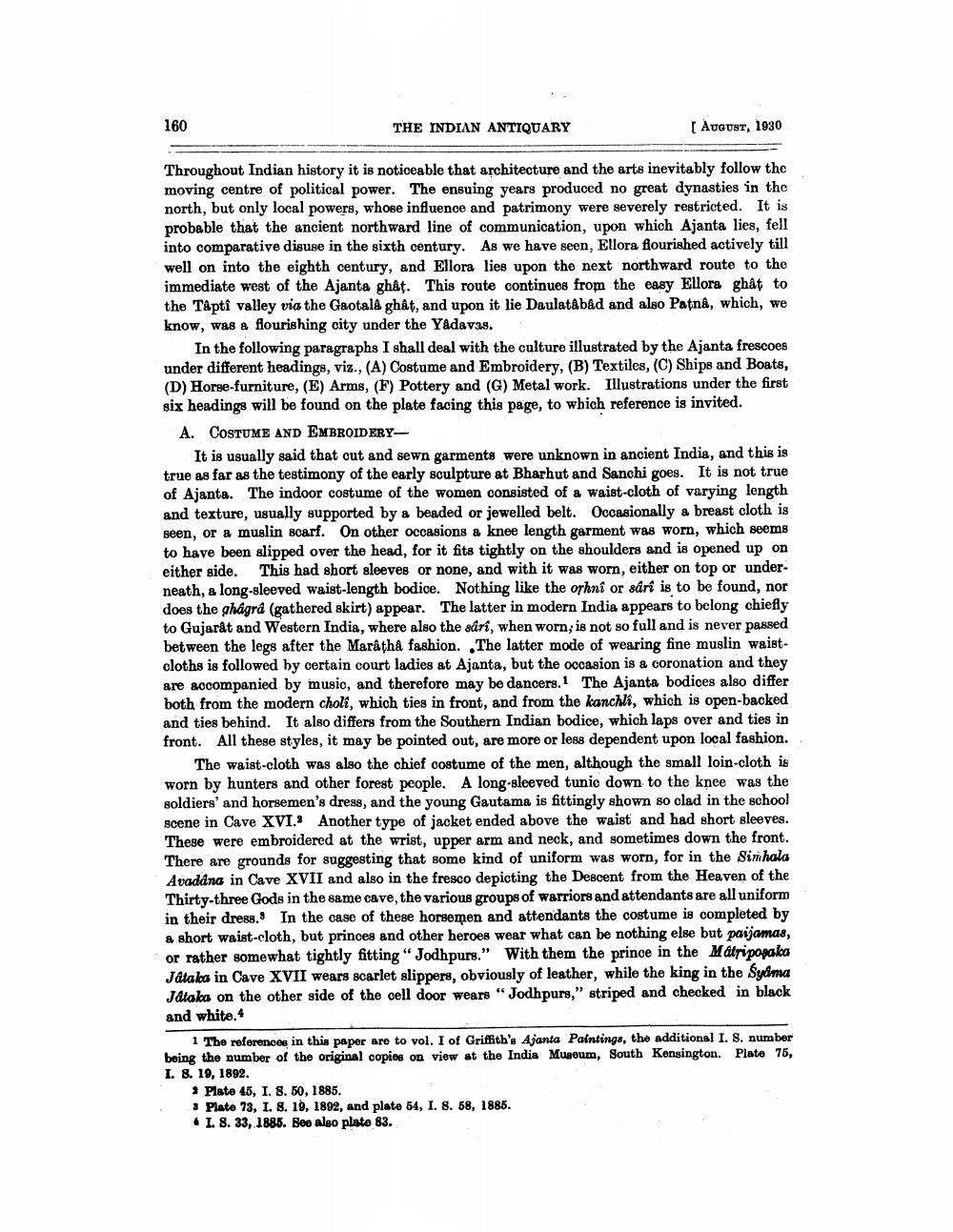________________
160
THE INDIAN ANTIQUARY
[ August, 1930
Throughout Indian history it is noticeable that architecture and the arts inevitably follow the moving centre of political power. The ensuing years produced no great dynasties in the north, but only local powers, whose influence and patrimony were severely restricted. It is probable that the ancient northward line of communication, upon which Ajanta lies, fell into comparative diguse in the sixth century. As we have seen, Ellora flourished actively till well on into the eighth century, and Ellora lies upon the next northward route to the immediate west of the Ajanta ghất. This route continues from the easy Ellora ghất to the Tapti valley via the Gaotalâ ghât, and upon it lie Daulatabad and also Patna, which, we know, was a flourishing city under the Yadavas.
In the following paragraphs I shall deal with the culture illustrated by the Ajanta frescoes under different headings, viz., (A) Costume and Embroidery, (B) Textiles, (C) Ships and Boats, (D) Horse-furniture, (E) Arms, (F) Pottery and (G) Metal work. Illustrations under the first six headings will be found on the plate facing this page, to which reference is invited. A. COSTUME AND EMBROIDERY
It is usually said that cut and sewn garments were unknown in ancient India, and this is true as far as the testimony of the early sculpture at Bharhut and Sanchi goes. It is not true of Ajanta. The indoor costume of the women consisted of a waist-cloth of varying length and texture, usually supported by a beaded or jewelled belt. Oocasionally a breast cloth is seen, or a muslin scarf. On other occasions a knee length garment was worn, which seems to have been slipped over the head, for it fits tightly on the shoulders and is opened up on either side. This had short sleeves or none, and with it was worn, either on top or underneath, a long-sleeved waist-length bodice. Nothing like the orhni or sári is to be found, nor does the ghagra (gathered skirt) appear. The latter in modern India appears to belong chiefly to Gujarat and Western India, where also the sári, when worn; is not so full and is never passed between the legs after the Marathå fashion. The latter mode of wearing fine muslin waistcloths is followed by certain court ladies at Ajanta, but the occasion is a coronation and they are socompanied by music, and therefore may be dancers, 1 The Ajanta bodices also differ both from the modern choli, which ties in front, and from the kanchli, which is open-backed and ties behind. It also differs from the Southern Indian bodice, which laps over and ties in front. All these styles, it may be pointed out, are more or less dependent upon local fashion.
The waist-cloth was also the chief costume of the men, although the small loin-cloth is worn by hunters and other forest people. A long-sleeved tunio down to the knee was the soldiers' and horsemen's dress, and the young Gautama is fittingly shown so clad in the school scene in Cave XVI. Another type of jacket ended above the waist and had short sleeves. These were embroidered at the wrist, upper arm and neck, and sometimes down the front. There are grounds for suggesting that some kind of uniform was worn, for in the Sinhala Avadana in Cave XVII and also in the fresco depicting the Descent from the Heaven of the Thirty-three Gods in the same cave, the various groups of warriors and attendants are all uniform in their dress. In the case of these horsemen and attendants the costume is completed by & short waist-cloth, but princes and other heroes wear what can be nothing else but paijamas, or rather somewhat tightly fitting " Jodhpurs." With them the prince in the Matripopala Jataka in Cave XVII wears scarlet slippers, obviously of leather, while the king in the Syima Jataka on the other side of the cell door wears "Jodhpurs," striped and checked in black and white.
1 The references in this paper are to vol. I of Griffith's Ajanta Paintings, the additional I. 8. number being the number of the original copies on view at the India Museum, South Kensington. Plate 75, I. 8. 19, 1892.
Plate 45, I. 8. 50, 1885. 3 Plate 73, I. 8. 19, 1892, and plate 54, I. 8. 58, 1885. . L. 8. 33, 1885. See also plate 83.




